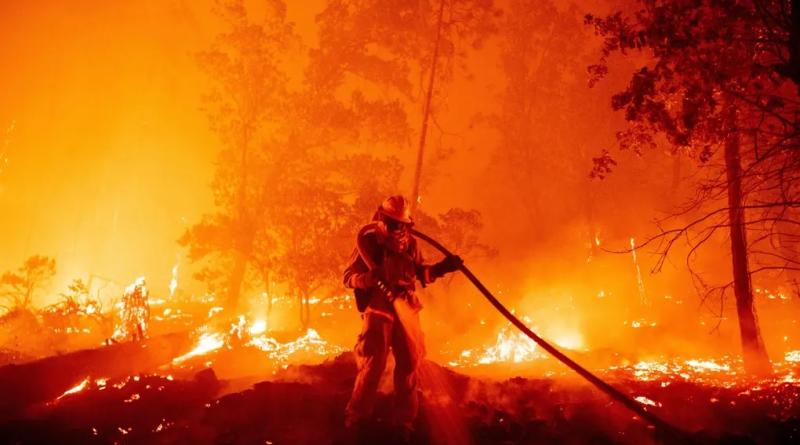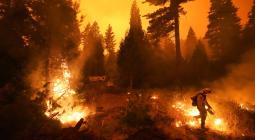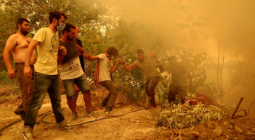‘Loading the dice’: climate crisis could increase southern California wildfires

Global heating will cause ‘megafires resistant to fire suppression practices’ with 25% of land being burned by 2040
A convergence of dangerous weather conditions, exacerbated by the climate crisis, has set the stage for southern California to see an increase in catastrophic wildfires over the coming decades, according to a new study.
Southern California, home to 23 million people, has largely been spared the kind of extreme fire escalation experienced in the northern part of the state, but models drawn up by researchers at the University of California, Los Angeles, have predicted that will change.
Wildfires in southern California are often driven by dry winds, low humidity and high temperatures, and the climate crisis is creating the perfect conditions for them to burn hotter, faster and more frequently. Analyzing data from 49 climate stations scattered across the southern coast from Santa Barbara to San Diego, the UCLA study found that the region could see double the number of what scientists call “large fire days” by 2100 if greenhouse gas emissions are not curbed.
Even in a more moderate scenario, where heating is slowed, the researchers’ models showed a 60% increase in high-risk days compared with the late 20th century.
“Things are going to get worse,” Glen MacDonald, a professor of geography at UCLA and the lead author of the study, said.
The researchers analyzed a series of variables that can increase fire risks and found certain climatic characteristics – especially how dry the air is – usually determine when the biggest blazes erupt. “From that we found that you could sort of predict when you were going to have your large fire probability in southern California,” MacDonald said.
After determining the patterns most associated with wildfires, they modeled how those patterns might change in the decades ahead. They found that not only will days get drier, but those days will start to show up earlier in the spring and stick around later into the autumn, thus “extending the probability to a greater part of the year”, he added. They found these high-risk days would probably increase from the 36 days a year documented from the 1970s to the late 1990s, to 71 days a year by 2070.
These conditions won’t just produce more fires – they will also affect fire behavior, making them more destructive and harder to contain.
Southern California’s landscapes, which are dominated by grassland and shrubland rather than large forests, burn and recover differently from their northern neighbors. Decades of poor land management and tamping down on Indigenous practices of prescribed burnings has also left northern California’s forests overcrowded and primed for bad burns – an issue that’s less prevalent in the south.
That’s partly why, MacDonald says, the regions have had such different experiences with wildfire. “It’s not like climatologically we have been dodging the bullet – but we just haven’t seen the same impact that we see in the more remote regions of northern California and the Sierra Nevada in those forested systems.”
That doesn’t mean the rest of the state will be spared. A separate study released last year, led by researchers at University of California, Irvine, looked at the temperatures in the Sierra Nevada range during 450 fires that ignited there between 2001 and 2020. Their analysis shows that, as warming gets worse and temperatures continue to spike, fires in Sierra Nevada could increase by 20% or more over the next 20 years. The amount of land burned will increase even more sharply, rising by 25% by the 2040s.
“Wildfires are really sensitive to small changes in temperatures,” says Aurora Gutierrez, a project specialist in UCI’s department of earth system science and lead author of the Sierra Nevada study. The researchers found that for every 1C (1.8F) rise in temperature, fire risk increases by up to 22%. Over the next two decades the region is expecting temperatures to increase by 2C (3.6F).
“When it’s hot for a long time it leads to these megafires that are resistant to fire suppression practices,” Gutierrez says. “In extreme conditions like this, whatever is going to burn is going to burn – and you can’t really do much to stop it.”
Fires are already exhibiting more extreme behavior, adding new challenges to containment efforts.
One new phenomenon, documented in a study published on Wednesday and led by MacDonald’s colleagues at UCLA, is blazes are more likely to burn through the night. The study found that, globally, night fires have grown 7.2% in intensity over the last two decades thanks to hot, dry conditions that persist after sunset, closing what was once an essential window to tame the flames.
While MacDonald sees these results as a clear call for immediate action to reduce emissions, he emphasized that the models show predictions, not guarantees. There are still ways to avoid a future with even more catastrophic wildfires.
“What we are seeing with the climate system is we are loading the dice,” MacDonald says. “It’s a roll of the dice but we are loading them with more and more days where you have this high probability of a fire and that spark has a greater opportunity to occur when it’s really going to cause damage.”
cover photo: A firefighter douses flames during the Creek fire in unincorporated Madera county, California, on 7 September 2020. Photograph: Josh Edelson/AFP/Getty Images





